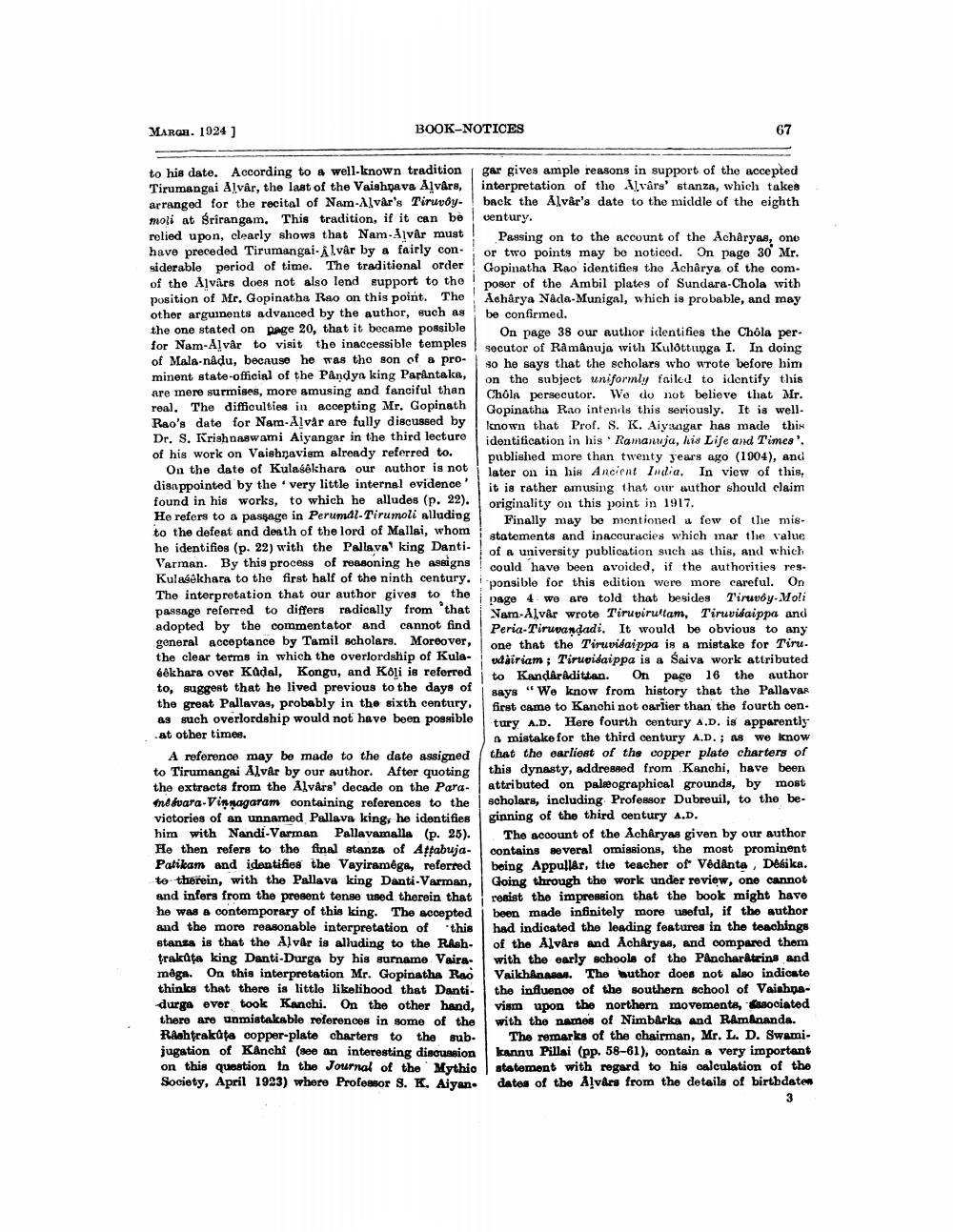________________
MARCH. 1924 ]
BOOK-NOTICES
67
to his date. According to a well-known tradition gar gives ample reasons in support of the accepted Tirumangai Alvår, the last of the Vaishnava Alvârs, interpretation of the Alvárs' stanza, which takes arranged for the recital of Nam-Alvår's Tiruvoy- back the Alvår's date to the middle of the eighth moli at Srirangam. This tradition, if it can be century. relied upon, clearly shows that Nam-AvAr must
Passing on to the account of the Acharyas, ono have preceded Tirumangai. Alvår by a fairly con or two points may be noticed. On page 30 Mr. siderable period of time. The traditional order Gopinatha Rao identifies tho charya of the comof the Alvars does not also lend support to the poser of the Ambil plates of Sundara-Chola with position of Mr. Gopinatha Rao on this point. The Acharya Nada Munigal, which is probable, and may other arguinents advanced by the author, such as be confirmed. the one stated on page 20, that it became possible On nage 38 our author identifies the Chola per for Nam-Alvar to visit the inaccessible temples secutor of Ramânuia with Kulottunga I. In doing of Mala-nadu, because he was the son of a pro
80 he says that the scholars who wrote before him minent state-official of the Pandya king Parantaka,
on the subject uniformly failed to identify this are mere surmises, more amusing and fanciful than
Chola persecutor. We do not believe that Mr. real. The difficulties in accepting Mr. Gopinath
Gopinatha Rao intenels this seriously. It is wellRao's date for Nam-Alvar are fully discussed by Inown that Prof. S. K. Aiyengar has made this Dr. S. Krishnaswami Aiyangar in the third lecture
identification in his Ramanuja, lis Life and Times'. of his work on Vaishnavigm already referred to.
published more than twenty years ago (1904), and On the date of Kulasekhare our author is not later on in his Ancient India, In view of this, disappointed by the very little internal evidence it is rather amusing that our author should claim found in his works, to which he alludes (p. 22). originality on this point in 1917. He refers to a passage in Perumal-Tirumoli alluding
Finally may be nicntioned a few of uie mis. to the defeat and death of the lord of Mallai, whom
statements and inaccuracies which mar the value he identifies (p. 22) with the Pallava king Danti.
of a university publication such as this, and which Varman. By this process of reasoning he assigns
could have been avoided, if the authorities res. Kulagekhara to the first half of the ninth century. Iponsible for this edition were more careful. On The interpretation that our author gives to the
page 4 we are told that besides Tiruvoy- Voli passage referred to differs radically from that
Nam-Alvår wrote Tiruvirultam, Tiruvisaippa and adopted by the commentator and cannot find
Peria-Tiruvandadi. It would be obvious to any general acceptance by Tamil scholars. Moreover,
one that the Tiruvisaippa is a mistake for Tiru. the clear terms in which the overlordship of Kula utairiam ; Tiruvidaippa is a Saiva work attributed
Akhara over Kadal, Kongu, and Koli is referred to KandArâditten. On page 16 the author to, suggest that he lived previous to the days of says "We know from history that the Pallavas the great Pallavas, probably in the sixth century.
first came to Kanchi not earlier than the fourth cen. as such overlordship would not have been possible tury A.D. Here fourth century A.D. is apparently at other times.
mistake for the third century A.D.; As we know A reference may be made to the date assigned that the earliest of the copper plate charters of to Tirumangai Alvar by our author. After quoting this dynasty, addressed from Kanchi, have been the extracts from the Alvare' decade on the Para. attributed on paleographical grounds, by most mavaraVinnagaram containing references to the scholars, including Professor Dubreuil, to the bevictories of an unnamed Pallava king, he identifies ginning of the third century A.D. him with Nandi-Varman Pallavamalla (p. 25). The account of the Acharyas given by our author He then refers to the final stanza of Affabuja- contains several omissions, the most prominent Patikam and identifies the Vayiraméga, referred being Appullar, the teacher of Vedanta, Desika. to therein, with the Pallava king Danti-Varman, Going through the work under review, one cannot and infers from the present tense used therein that resist the impression that the book might have he was a contemporary of this king. The accepted been made infinitely more useful, if the author and the more reasonable interpretation of this had indicated the leading features in the teachings stanza is that the Alvar is alluding to the Rash- of the Alvars and Acharyas, and compared them trakata king Danti-Durga by his surname Vaira- with the early schools of the Pancharteins and måga. On this interpretation Mr. Gopinatha Rao Vaikinasas. The author does not also indicate thinks that there is little likelihood that Danti- the influence of the southern school of Vaishnadurga ever took Kanchi. On the other hand, vism upon the northern movements, asociated there are unmistakable references in some of the with the names of NimbArka and Ramananda. Rashtrakata copper-plate charters to the sub- The remarks of the chairman, Mr. L. D. Swamijugation of Kanchi (see an interesting discussion kannu Pillai (pp. 58-61), contain a very important on this question in the Journal of the Mythic statement with regard to his calculation of the Society, April 1923) where Professor S. K. Aiyan. dates of the Alves from the details of birthdaten




